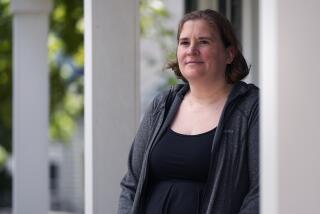School Lunches : Back to School for Cafeteria Chiefs
- Share via
Food services directors, the people who decide whether spaghetti sauce is made of ground beef or ground turkey, whether vegetables are canned or frozen and whether cookies should be served in childrens’ lunches, went back to the school this summer. Their assignment: To imagine, during a 10-hour course that they were their food services employees--managers, cooks, dishwashers and servers. This wasn’t easy considering most of a director’s day is spent reading government surplus commodities lists and tasting the latest innovation in corn dogs. Many of them haven’t been in a kitchen for years.
It was all part of a state Education Department experiment that will be used throughout the state to train food services employees. The ultimate goal is to make the school lunch program more appealing to students.
“How many tablespoons are in an ounce?” wondered one of the 20 directors as she mixed up a batch of cookies. This was her first visit to the state’s new Healthy Menu Planning Child Nutrition Program Management Center (located in the home economics department at California State University Long Beach). She and the other directors were there to evaluate the state’s curricula, and then learn the communication and marketing skills needed to teach it to their employees.
The participants prepared high-fat and lower-fat versions of typical menu items, then compared them for taste and appearance. Hard shell tacos were compared to soft, reduced fat chocolate chip cookies to regular, ground beef breakfast sandwiches to ground turkey. Sweetened and unsweetened canned fruits were also compared to fresh. The volunteers looked at the fat and sodium content of foods they commonly purchase from outside vendors. As employees, they learned to classify foods according to their primary nutrients by playing “healthy food” word search games. They made posters spotlighting the Four Food Groups to demonstrate how visual aids make the cafeteria more inviting.
“It’s been hard to put yourself in the position of being a general assistant,” says Jana Harrison, food services supervisor of the Mount Diablo Unified School District. “So much of this I already know. But we need this kind of thing so badly because individual school districts can’t give (us) this kind of training.”
This training course is part of a comprehensive SDE plan called “Healthy Kids Healthy California,” aimed at improving the overall health of California children. Although quantitative nutrition guidelines for the school lunch menu haven’t yet been developed, this pilot “Train the Trainer” program is one of the many ways SDE has begun assessing its existing food services system and looking for ways to enhance it.
While some school districts in California have already taken steps to reduce the amount of fat, sugar and sodium in their lunch menus, says Roberta Peck, registered dietitian and Nutrition Education and Training Specialist, SDE, as few as 4% actually know what percent of fat calories is in their menu items. Peck says the new programs are intended as a tool to improve this number.
One goal of the Healthy Kids plan is to promote overall student health. Using classroom curricula, SDE will emphasize the following areas: disease prevention and risk reduction; physical education to expose students from kindergarten to age 12 to sports and activities that they enjoy and can use throughout life; health awareness, to help them spot problems that could interfere with their hearing and vision; health promotion for staff to make sure teachers are role models; counseling and psychological services for the mental, emotional and social well-being of students and staff for a positive school climate; and making sure the school is a safe environment.
The other major objective of the Healthy Kids plan is to reshape food services departments and eventually improve the way school cafeterias are run. Train the Trainer is one aspect of this project.
“The centers,” says Gail Frank, registered dietitian and director of the training program, “are a marvelous way to decentralize the state effort and bring it down to a manageable level without giving out a mandate written on paper that you must (change your program).”
More to Read
Sign up for Essential California
The most important California stories and recommendations in your inbox every morning.
You may occasionally receive promotional content from the Los Angeles Times.










